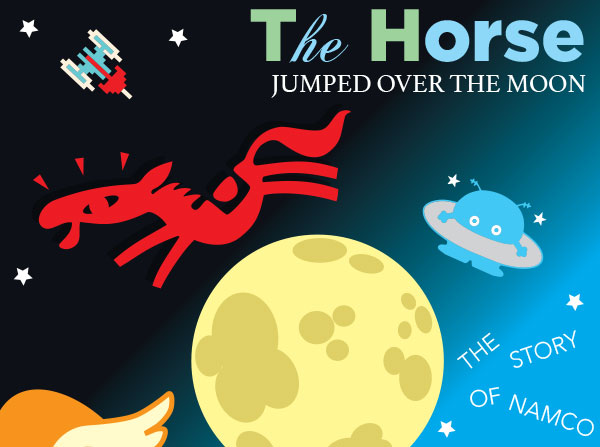
The roots of Wonder Eggs went fairly deep. They extended back to the foundation of Namco in 1955, and the philosophy that guided the company over the decades. Bringing the theme park to life was more than relocating the popular Galaxian³, and Tower of Druaga “Hyper Entertainment” attractions from Expo ’90 at Osaka’s Tsurumi Ryokuchi Park to a corner of Tokyo’s Futako-Tamagawa Park in 1992. The mythology of Laperot village, the Goddess Elds, and the Pyrallis helped create a world for guests to explore. Namco called it “The World of Wonder Imagination.” Laperot was a place that mixed science, and magic in equal measure. The origins of this fantastic place most likely came from Tower of Druaga series creator
Masanobu Endō. He had previously designed the arcade hits Xevious and
Grobda. Much of Laperot’s story was inspired from Sumerian and Babylonian mythology including The Epic of Gilgamesh, and The Tower of Babel.
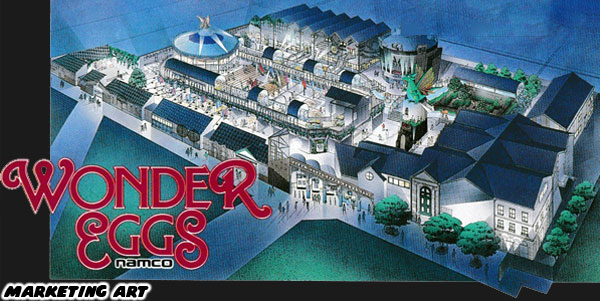
I mentioned previously that Namco’s financing people were mad at the game designers for how much they spent on the Expo ’90 attractions. They warned that they would never be allowed to spend that kind of money again. From this point forward anything the team built had to fall within a set budget. Of course this was not the news that they wanted to hear when creating a theme park. Thankfully they would be allowed to bring over their Expo ’90 gems, but they needed to add much more into the park, for much, much less. The designers always up for a challenge came up with “Participatory Story Attractions.” They would use the lessons from game design to create interactive walk through attractions like The Fortune Telling Witch’s house, and The Murder Hotel. These places turned the visitors into the main characters of an “unfamiliar world, in an unknown era.” They were unlike anything available at any other park. Like a hybrid of an escape room, and a Halloween maze, with multiple paths, and outcomes. These also rewarded the best players with prizes, and even discount tickets.
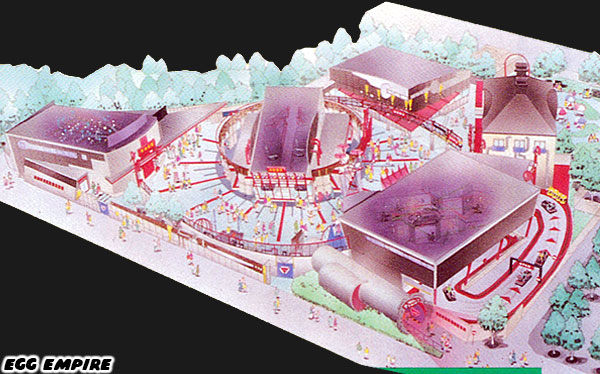
The initial goal from Namco was to build a limited-time urban theme park. Something that lasted exactly four years then would be retired. It was a proof-of-concept from the CEO Masaya Nakamura that audiences were ready to engage in a new form of play. Mr. Nakamura was right. Wonder Eggs was a hit. Within a year they had a million visitors. This allowed the financing people to loosen the purse strings. Designers now had the freedom to “plus” attractions that needed work. This also made the company realize that they should expand while the market was hot. Unfortunately for them Wonder Eggs had maximized every square inch of property. In order to build new attractions Namco needed to buy more land from the old Futako-Tamagawa amusement park. They did so quickly, and started a marketing blitz. They would build a second gate across the street. They called it Tamago Teikoku, the Egg Empire.
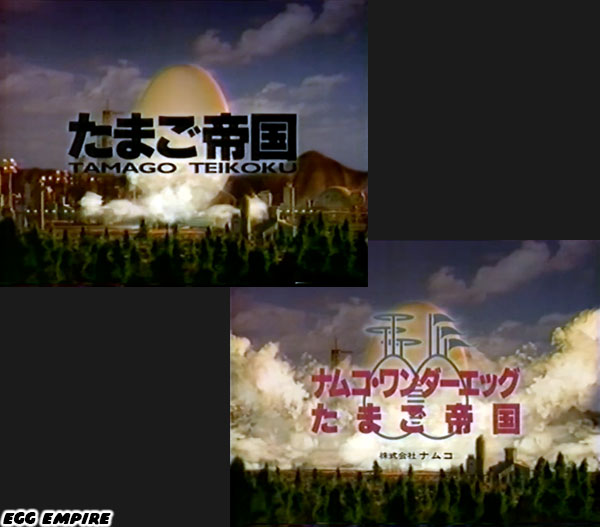
This location had a new look, and feel to it. The slogan for this park was “The Alchemy Nation of Play.” Namco would have it finished within two years. It was an amazing turnaround from start to finish. Attendance was not slowing down at either park. Namco had to rethink their goals. At the end of four years neither Wonder Eggs, nor the Egg Empire would be retired. The main park would get a refresh, and a new theme would be applied. Namco Wonder Egg 2 opened on July 20 1996 with the slogan “Love and Success.” It had earned over 5 million visitors. Namco Wonder Egg 3 opened on April 3 1999 with the slogan “Dreams and Romance.” Namco announced that they would officially retire both parks on December 31, 2000. The closure would mark the end of the 20th Century, and signal the birth of a new millennium. It was commendable that with a relatively small budget the team at Namco managed to create a park that lasted twice as long as the company had originally planned. Before they closed they would exceed 6 million visitors.
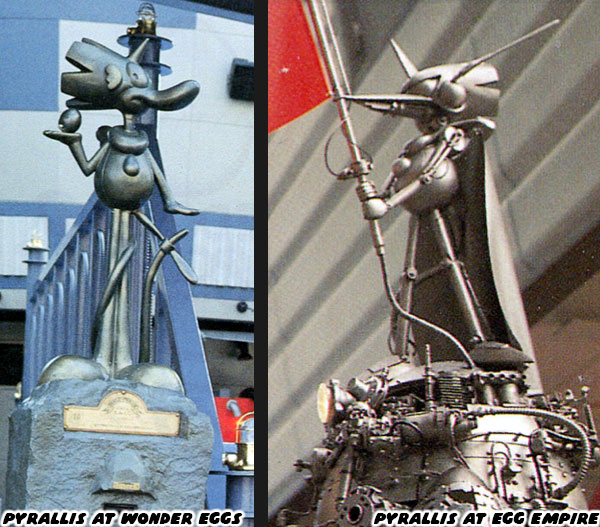
The Egg Empire was a smaller sister park that had a different look, and feel altogether. This was apparent with the advertising, architecture, and even the new Pyrallis.
The original four Pyrallis from Wonder Eggs were brightly colored, cartoonish mascots. The ones for the Egg Empire were drawn in grayscale. They had sharp angles, and looked like cybernetic constructs. They reflected the industrial look of the new park. It was presented as a park from the future visiting our timeline. There was very little written, or published on these mechanized Pyrallis. As I was reading the book “Man, Play and Games” from where Namco took the names Agon, Alea, Ilinx, and Mimicry for the Pyrallis. I began wondering of the ones from the Empire had names as well. Two of the other words that Roger Caillois brought up in his description of play were Tyche (luck), and Moira (destiny). These were the unofficial names I gave the new characters.
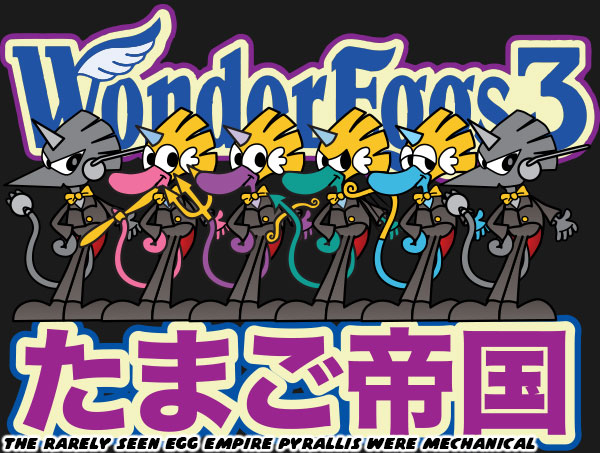
So what were the attractions that went into the Egg Empire? How was it similar to Wonder Eggs, and how did it differ? During my research I would argue that the Egg Empire had an even more restrictive budget. Wonder Eggs was already a small theme park. This new park was even smaller. The financing people at Namco struck again. They wanted to build the best second gate they could, but for the smallest budget possible. The Empire featured experiences were very much “off the shelf” amusement rides. These were similar to things that could be found at other parks the world over. The best thing that the Egg Empire had going for it was the art, and architecture featured in the park. We will dive into it in the next blog. I hope to see you back for that. Were there any defunct parks that you visited? Please tell me about it in the comments section. As always if you would like to sponsor me
please visit my Patreon page and consider donating each month, even as little as $1 would help make better blogs and even podcasts!
Wonder Eggs, and Egg Empire research collected from: Wonder Eggs Guide Map, Namco Graffiti magazine, the book “All About Namco II", NOURS magazine, The Namco Museum, Namco Wiki, Ge-Yume Area 51 Shigeki Toyama Collection, mcSister magazine, first person attraction details from Yoshiki. Event details from Hole in the Socks.












No comments:
Post a Comment